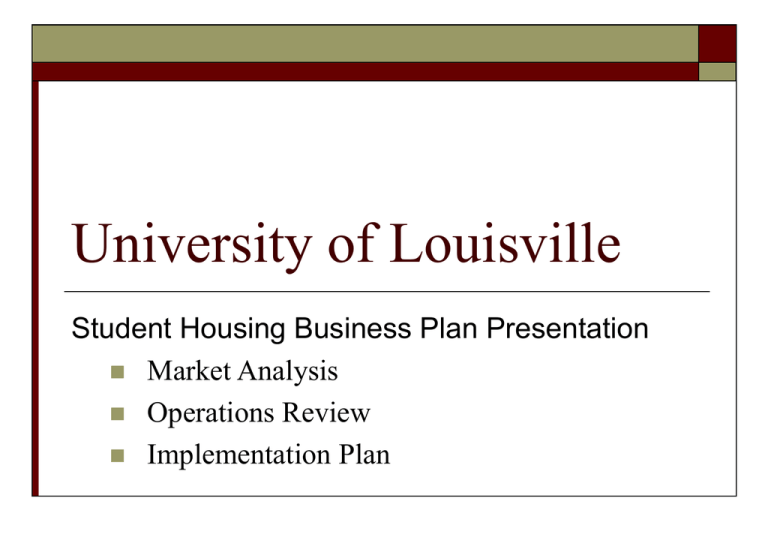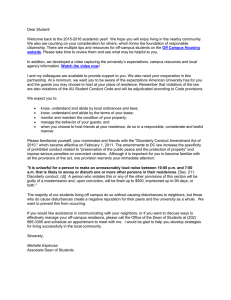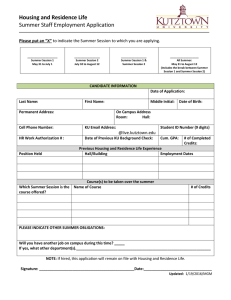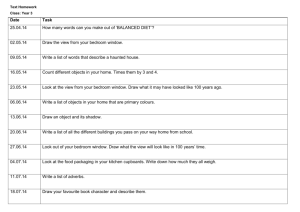University of Louisville Student Housing Business Plan Presentation Market Analysis Operations Review
advertisement

University of Louisville Student Housing Business Plan Presentation Market Analysis Operations Review Implementation Plan University of Louisville Market Analysis Benchmarking Student Survey Demand Projections Market Analysis Benchmarking Profile of Off-Campus Properties Sample Size: 22 properties located within 15 miles of campus Property Size: 42 to 689 units; median 208 units Leases: All offer 12-month leases; majority offer 6or 9-month leases (most for an additional charge) Security deposits: $0 to $450 Occupancy: 77% to 100%; median 92% 3 Market Analysis Benchmarking Off-Campus Rents by Unit Type High $369 $550 $562 $779 $930 $345 $459 $390 $460 $890 Low $1,080 Median $565 Efficiency 1 Bedroom 2 Bedroom 3 Bedroom (n=6) (n=20) (n=21) (n=8) 4 Market Analysis Benchmarking Peer Institutions SUNY at Buffalo University of Cincinnati University of Illinois – Chicago University of Kentucky – Lexington University of Memphis University of Missouri – Columbia University of Nevada – Reno University of Pittsburgh University of South Florida Wayne State University 5 Market Analysis Benchmarking Peers: Beds/Units as a % of Enrollment Wayne State University University of South Florida University of Cincinnati 9% 10% University of Nevada-Reno 12% University of Louisville 12% University of Illinois-Chicago University of Memphis University of Louisville 12% 12% 18% Proposed University of Missouri-Columbia 23% University of Kentucky-Lexington 23% University of Pittsburgh SUNY at Buffalo 7% Median: 12% 25% 65% 6 Market Analysis Benchmarking Peers: Fall 2004 Occupancy University of Memphis University of Nevada-Reno University of Missouri-Columbia University of Louisville 82% 93% 97% 98% University of Pittsburgh 99% University of Illinois-Chicago 99% SUNY at Buffalo 100% University of Cincinnati 100% Median: 98.5% 7 Market Analysis Benchmarking Peers: Room Rate Traditional Double University of Memphis University of South Florida University of Louisville $3,108 $3,168 University of Kentucky-Lexington $3,363 University of Missouri-Columbia $3,400 University of Nevada-Reno University of Pittsburgh $4,190 $4,510 University of Louisville $4,600 SUNY at Buffalo $4,636 University of Cincinnati $4,680 University of Illinois-Chicago $2,620 Median: $3,800 Proposed $4,790 8 Market Analysis Benchmarking Peers: Room Rate Suite Double University of Memphis University of South Florida University of Louisville $3,108 $3,777 University of Kentucky-Lexington $4,250 Wayne State University $4,280 SUNY at Buffalo $4,636 University of Missouri-Columbia $4,750 University of Pittsburgh $4,790 University of Cincinnati $5,138 University of Louisville $5,140 Proposed University of Illinois-Chicago University of Nevada-Reno $2,912 Median: $4,636 $5,210 $5,290 9 Market Analysis Student Survey Off-Campus Housing Costs Per Person Single Students $569 $144 Utilities Rent $417 $350 $352 $100 $102 $250 $250 $117 $425 $300 One Bedroom Two Bedroom Three Bedroom Four Bedroom (n=45) (n=93) (n=47) (n=23) 10 Market Analysis Student Survey Off-Campus Housing Costs Per Unit Married/Family Students Utilities $870 Rent $625 $175 $450 $685 $245 $160 $525 $625 One Bedroom Two Bedroom Three Bedroom (n=16) (n=38) (n=11) 11 Market Analysis Student Survey Median Price Per Unit Comparison With Market Rents Efficiency One Bedroom Two Bedroom Three Bedroom ASL Market Sample $460 $459 $562 $779 Single Student Survey Respondents $392 $425 $600 $750 Married/Family Survey Respondents - $450 $525 $625 Market Students are generally renting at or below the median price in the market Married/family students generally seek lower cost housing than single student who share the rent 12 Market Analysis Student Survey Unit Types and Rents Tested in the Survey Unit Type Description Tested Monthly AY Rent Equivalent Renovated Traditional Double Full renovation that includes new furniture, new wall and floor finishes, replacement of heating and cooling, plumbing, electrical systems, and new windows so that the hall is like when it was first built $3,920 $436 Improved Traditional Double Full renovation as described above plus more private and less crowded bathrooms, new study/lounge areas, expanded public areas including kitchens, laundries, and meeting rooms, improved in-room temperature control, and new acoustically insulated windows $4,600 $511 New Semi-Suite Double New construction, two double rooms sharing a semi-private bath (similar to Kurz Hall) $5,140 $571 New Semi-Suite Single New construction, two single rooms sharing a semi-private bath (similar to Kurz Hall) $5,860 $651 13 Market Analysis Student Survey Most Important Factors Respondents Considered in their Housing Decision Affordable cost Proximity to campus facilities and services Adequate living space Have personal space/privacy Have own bedroom Security Overall On Campus Off Campus Freedom from rules and regulations Physical condition of the housing Ability to meet other students/social atmosphere Availability of parking 0 500 1000 1500 Weighted Scale 2000 2500 14 Market Analysis Student Survey Interest in Proposed Housing 9% Would not have lived there. 9% 41% 57% 15% Probably would not have lived there (less than a 50/50 chance). 26% Might have lived there (50/50 chance). 37% 18% 45% 20% On Campus Off Campus 18% Total Definitely would have lived there. 15 Market Analysis Student Survey Reasons for Lack of Interest in Proposed Housing The housing is too expensive Prefer to rent off campus I live with my parents/relatives Concerned about the level of rules & regulations I do not want to move I live with my spouse and/or children Prefer Bettie Johnson Hall I already own a home Prefer existing traditional campus housing Off Campus Prefer Louisville Hall On Campus Prefer University Tower or Medical/Dental Apartments 0 100 200 300 400 Number of Respondents 500 600 16 Market Analysis Demand Projections Off-Campus Student Demand – Fall 2004 Class Full-time Off-Campus Enrollment Definitely Interested Capture 50% Rate Closure Might Be Interested Capture 25% Rate Closure Projected Demand Freshmen 2,167 8% 82 30% 164 245 Sophomores 1,884 2% 22 17% 79 101 Juniors Seniors 2,120 5% 48 21% 114 161 2,285 3% 36 17% 98 134 454 641 8,456 187 Overall, 7.5% of current off-campus residents “would” or “might” be interested in the proposed housing Significant percentage of off-campus freshmen interested 17 Market Analysis Demand Projections On-Campus Student Demand – Fall 2004 Full-time On-Campus Enrollment Definitely Interested Might Be Interested Capture Rate 50% Closure Capture Rate 25% Closure Projected Demand 1,550 50% 389 35% 135 524 Sophomores 604 45% 135 35% 53 187 Juniors 164 30% 24 53% 22 46 Seniors 68 33% 11 33% 6 17 215 775 Class Freshmen 2,386 560 Overall, 32% of current on-campus residents “would” or “might” be interested in the proposed housing Lower-division students most interested 18 Market Analysis Demand Projections Total Demand by Unit Preference – Fall 2004 Unit Type Renovated Traditional Double Improved Traditional Double New Semi-Suite Double New Semi-Suite Single Total 2004 Rent Per Student Per AY $3,920 $4,600 $5,140 $5,860 Off-Campus Students Preference Demand On-Campus Students Preference Demand Total Projected Demand 18% 30% 20% 32% 117 194 127 204 20% 42% 19% 19% 158 323 149 144 274 517 276 348 100% 641 100% 775 1,416 Demand at higher rents for renovated traditional halls and new semi-suites still exceeds the proposed supply of 1,033 beds 19 University of Louisville Operations Analysis Progress Report Challenges and Opportunities Visioning the Future Operations Review Overview Four Aggressive Years of Growth and Improvements Challenges and Opportunities Remaining Major issues and recommendations for University Leadership Major Issues and recommendations for Housing and Residence Life Visioning the Future 21 Operations Review Progress Report Four Years of Growth and Improvement General fund subsidy has been eliminated from the housing budget Student housing capacity has doubled in four years from 9% to over 18% of fulltime undergraduate students ULP surpluses have been used, in part, to expand renovations in traditional U of L residence halls 22 Operations Review Progress Report …More Improvements Housing license cancellation policies and penalties have been strengthened to reduce mid year vacancies and improved spring occupancy by 2-3 % annually. Space renovated in Threlkeld for the Etscorn Honors Center Publications and marketing efforts have been enhanced considerably Policy review has been completed with policy adaptations for enhanced student service have been implemented 23 Operations Review Progress Report … And Even More Improvements… Strengthened overall residence hall security and fire safety program with access control and sprinkler systems House calls and Facility Assistant visits implemented in each hall Enhanced First Year Experience for students in residence halls through personal calls before fall semester, meetings with first year students (MPACT), roommate contracts, and several other initiatives 24 Operations Review Challenges and Opportunities Recommendations for University Leadership Effect the coordinated marketing and management of UofL Housing with ULP For a specified period of years consistent the housing master plan, re-direct general fund overhead charges and housing budget surpluses directly to the residential capital projects 25 Operations Review Challenges and Opportunities Recommendations for University Leadership Effect the coordinated marketing and management of UofL Housing with ULP For a specified period of years consistent the housing master plan, re-direct general fund overhead charges and housing budget surpluses directly to the residential capital projects 26 Operations Review Challenges and Opportunities Recommendations for University Leadership Delegate to the Housing and Residence Life management team the decisions of where students should be assigned based on market forces and educational needs. Develop a plan to eliminate the requirement that upper class students living on campus must purchase a meal plan 27 Operations Review Challenges and Opportunities Recommendations for University Leadership Appoint a task force of faculty and student affairs and housing staff to develop a strategic plan for an expanded focus on residential learning Provide appropriate educational funds to support the residential learning initiatives needed to support recruitment and retention of students 28 Operations Review Challenges and Opportunities Housing and Residence Life How can the residential facilities and the on campus experience support recruitment and retention of students? Can we guarantee housing to all first year students? What is the primary focus of the educational experience in residence life? Developing business practices that enable full tracking of all fiscal issues while allowing reduction in operating costs Adapting practices where appropriate from the Allen & O’Hara management and marketing model 29 Operations Review Challenges and Opportunities Recommendations for Housing Leadership Develop a plan, in collaboration with enrollment management, to guarantee all first year students who apply by May 1st each year (and thereafter as well) Identify market niches and marketing strategies to increase overall fall occupancy by 2-3% within three years 30 Operations Review Challenges and Opportunities Recommendations for Housing Leadership Establish first year residence halls so that frontloaded student support can efficiently enhance their retention to the sophomore year Centralize residence education and student services around a simplified and focused residential experience to enhance the success of first year and other residential students 31 Operations Review Challenges and Opportunities Recommendations for Housing Leadership Reduce operating expenses through re-organization, more clearly focused student academic success activities, and reengineered business practices Develop a business model scenario applying the ULP operations structure to UofL Housing to clearly identify the added operating expenses of the current H&RL budget Analyze the differences to determine if the added expenses are justified by student outcomes in terms of recruitment or retention 32 Operations Review Visioning the Future A Vision for the Cardinal’s Residential Experience The educational experience of living on campus is recognized and valued Aggressively funded capital investments transform the traditional residence halls into engaged learning environments with comfortable and secure accommodations The recruitment of next generation students is enhanced by the quality residential facilities and programs at the University of Louisville 33 University of Louisville Implementation Plan Scope Financial Plan Summary Recommendations Implementation Plan Scope On-Campus Facilities Operations: All existing halls Capital Improvements: Residential master plan projects; others deferred ULP Beds Bettie Johnson, Kurz, and Campus Commons not in financial model Project surpluses source of revenue only Merger of management systems to be determined 35 Implementation Plan Scope ULP Merger/Acquisition Ownership to remain with ULH No financial benefit to University ownership Risk of financial default should remain with ULH Improving net available cash flow to University Additional debt service not advisable in wake of $50 million in new debt for residential master plan Management Short-term: Process re-engineering to approach vision Long-term: Realignment to single point of control within University to achieve vision 36 Implementation Plan Financial Plan Challenges and Constraints Rental rates are low High operating costs per bed Ongoing renewal and replacement Existing debt service Low reserve balance Outcome: Minimal debt capacity exists to fund renovations and quality construction 37 Implementation Plan Financial Plan Creating Debt Capacity Increase rents faster than operating costs Charge rental premiums for comprehensive renovations and new construction Trim operating costs and non-operating transfers Minimize capital expenses Outcome: Increased cash flow that can be leveraged to fund capital improvements 38 Implementation Plan Financial Plan Revenue Assumptions 6% annual escalation through FY2009 all beds 45% premium in year following project completion 95% post-completion occupancy Operating Cost Assumptions Current operating results as baseline 3% annual inflation (i.e., 3% less than rents) 10% reduction in year following completion 39 Implementation Plan Financial Plan Capital Improvements Capital Expenses Construction Costs 25% of annual surplus, if available Based on input from planning team $160 per gross square foot for new construction Development Budgets Include FF&E, design fees, development costs, contingency, and financing costs Average markup 33% of construction costs 40 Implementation Plan Financial Plan Financing and Reserves Bond coupon rate Term Earnings on reserves Reserves (New/Reno) 5.5% 30 yrs 5.0% 20 yrs 2.5% Balance of $1.0 million assumed as of 7/1/2005 Operating surpluses are transferred to reserves Operating deficits are funded from reserves Provide backup debt service coverage 41 Implementation Plan Financial Plan Summary Project 49A: West Hall 49B: Center Hall 49C: Wellness Hall New Commons Phase 1 Threlkeld Hall New Commons Phase 2 Stevenson Hall Miller Hall Unitas Towers University Tower Apts Medical Dental Complex Louisville Hall Project Type Vacate Vacate Vacate New Construction Renovation New Construction Vacate Renovation Deferred Deferred Deferred Deferred Revenue Beds/Units Development Budget 0 0 0 250 241 250 0 292 298 100 100 209 1,740 14,309,000 9,467,000 14,733,000 11,830,000 $ Scheduled Completion Aug-2006 Aug-2006 Aug-2006 Aug-2007 Aug-2008 Aug-2008 Aug-2009 Aug-2009 50,339,000 42 Implementation Plan Financial Plan Bed Distribution 3,500 3,000 2,500 ULP Beds Single Double Triple Quad 2,000 1,500 1,000 500 0 '06 '07 '08 '09 '10 '11 '12 '13 '14 '15 '16 '17 '18 '19 '20 43 Implementation Plan Financial Plan Operating Budget $16,000 $14,000 $12,000 $10,000 Net Revenue Operating Cost Net Operating Income $8,000 $6,000 $4,000 $2,000 $0 '06 '07 '08 '09 '10 '11 '12 '13 '14 '15 '16 '17 '18 '19 '20 44 Implementation Plan Financial Plan Debt Service Coverage 2.20 2.00 Target Min. Coverage Debt Service Coverage 1.80 1.60 1.40 1.20 1.00 0.80 '06 '07 '08 '09 '10 '11 '12 '13 '14 '15 '16 '17 '18 '19 '20 45 Implementation Plan Financial Plan Reserves $20,000 $15,000 Restricted for Debt Coverage Unrestricted Funds Transfer To (From) Reserves $10,000 $5,000 $0 '06 '07 '08 '09 '10 '11 '12 '13 '14 '15 '16 '17 '18 '19 '20 ($5,000) 46 Implementation Plan Summary Recommendations Establish advisory team to oversee the Plan Collaborate with Academic Affairs to establish living/learning environments Formalize inter-departmental business processes and agreements in support of full auxiliary status Seek operational and programmatic efficiencies to reduce operating costs Implement phased facilities renewal plan Move oversight and control of ULP management to Residence Administration 47 Extra Slides Follow 48 Implementation Plan ULP Analysis Key Provisions of Partnership Structure Annual Rent Equal to the Net Available Cash Flow Revenues less operating expenses, debt service, management fee (6%), and deposits to reserves Debt is non-recourse to the University Purchase Option Purchase price equal to outstanding principal balance Lessor responsible for loan recording fees and transfer taxes 49 Implementation Plan ULP Analysis Ground Rent Received Through FY2003, University reports $337,623 revenues received For FY 2004, ULP financial statements report ground lease expenses (payments?) Bettie Johnson Hall Kurz Hall $531,172 $435,494 Though less than projected because of early tenant issues, the properties now have the potential to return projected cash flow 50 Implementation Plan ULP Analysis Purchase Option for Bettie Johnson Hall ULP Debt Outstanding principal balance Annual debt service $23,485,000 $1,365,000 University annual debt service on refinancing $1,706,000 at 6.0% TIC $1,528,000 at 5.0% TIC $1,358,000 at 4.0% TIC 51 Implementation Plan ULP Analysis BJH Outstanding Balance and Refinancing 25,000,000 2,000,000 1,600,000 15,000,000 1,400,000 10,000,000 5,000,000 Series 2001 Pincipal P+I at 4% Refi Rate P+I at 5% Refi Rate P+I at 6% Refi Rate 20 01 20 02 20 03 20 04 20 05 20 06 20 07 20 08 20 09 20 10 20 11 20 12 20 13 20 14 20 15 - Annual P+I 1,800,000 20,000,000 Principal 1,200,000 1,000,000 800,000 52 Implementation Plan ULP Analysis BJH Breakeven Analysis of Purchase Estimated revenue for FY2005 $2,600,000 4% TIC Estimated Revenues $ Less: Debt Service $ Operating Cost Allowance $ Cost per Bed Cost per GSF 490 beds 175,277 gsf 2,600,000 5% TIC $ (1,358,000) $ 1,242,000 $2,535 $7.09 $ 2,600,000 6% TIC $ (1,528,000) $ 1,072,000 2,600,000 (1,706,000) $ $2,188 $6.12 UL operating expense budget for FY2006 is $2,995/bed or $10.43/gsf 894,000 $1,824 $5.10 53 Implementation Plan ULP Analysis Conclusions Housing will have difficulty operating within a cost structure necessary to breakeven Current ground lease payments would have to be replaced, requiring an even more efficient operation With planned renovations and new construction, the timing is not advantageous for taking on additional debt for the acquisition 54 Implementation Plan ULP Analysis Recommendation for BJH Do not exercise purchase option until Housing can meet or exceed current operating results In the near term, solve problem of split management systems through a re-engineering of processes rather than through acquisition In the long term, reconsider acquisition when planned renovations and construction are complete and if advantageous financially and risk-wise 55



